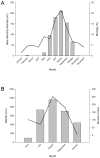Chrysomya putoria, a putative vector of diarrheal diseases
- PMID: 23133694
- PMCID: PMC3486903
- DOI: 10.1371/journal.pntd.0001895
Chrysomya putoria, a putative vector of diarrheal diseases
Abstract
Background: Chrysomya spp are common blowflies in Africa, Asia and parts of South America and some species can reproduce in prodigious numbers in pit latrines. Because of their strong association with human feces and their synanthropic nature, we examined whether these flies are likely to be vectors of diarrheal pathogens.
Methodology/principal findings: Flies were sampled using exit traps placed over the drop holes of latrines in Gambian villages. Odor-baited fly traps were used to determine the relative attractiveness of different breeding and feeding media. The presence of bacteria on flies was confirmed by culture and bacterial DNA identified using PCR. A median of 7.00 flies/latrine/day (IQR = 0.0-25.25) was collected, of which 95% were Chrysomya spp, and of these nearly all were Chrysomya putoria (99%). More flies were collected from traps with feces from young children (median = 3.0, IQR = 1.75-10.75) and dogs (median = 1.50, IQR = 0.0-13.25) than from herbivores (median = 0.0, IQR = 0.0-0.0; goat, horse, cow and calf; p<0.001). Flies were strongly attracted to raw meat (median = 44.5, IQR = 26.25-143.00) compared with fish (median = 0.0, IQR = 0.0-19.75, ns), cooked and uncooked rice, and mangoes (median = 0.0, IQR = 0.0-0.0; p<0.001). Escherichia coli were cultured from the surface of 21% (15/72 agar plates) of Chrysomya spp and 10% of these were enterotoxigenic. Enteroaggregative E. coli were identified by PCR in 2% of homogenized Chrysomya spp, Shigella spp in 1.4% and Salmonella spp in 0.6% of samples.
Conclusions/significance: The large numbers of C. putoria that can emerge from pit latrines, the presence of enteric pathogens on flies, and their strong attraction to raw meat and fish suggests these flies may be common vectors of diarrheal diseases in Africa.
Conflict of interest statement
The authors have declared that no competing interests exist.
Figures





References
-
- UN (2011) The Millennium Development Goals Report 2011. New York: United Nations.
-
- UNICEF/WHO (2009) Diarrhoea: why children are still dying and what can be done. Geneva: The United Nations Children's Fund (UNICEF)/World Health Organization (WHO).
-
- Kobayashi M, Sasaki T, Saito N, Tamura K, Suzuki K, et al. (1999) Houseflies: not simple mechanical vectors of enterohemorrhagic Escherichia coli O157:H7. Am J Trop Med Hyg 61: 625–629. - PubMed
-
- Greenberg B (1973) Flies and disease. Biology and disease transmission. Princeton, New Jersey: Princeton University Press.
-
- Greenberg B (1971) Flies and disease. Ecology, classifications and biotic associations. Princeton, New Jersey: Princeton University Press.
Publication types
MeSH terms
Grants and funding
LinkOut - more resources
Full Text Sources
Miscellaneous

